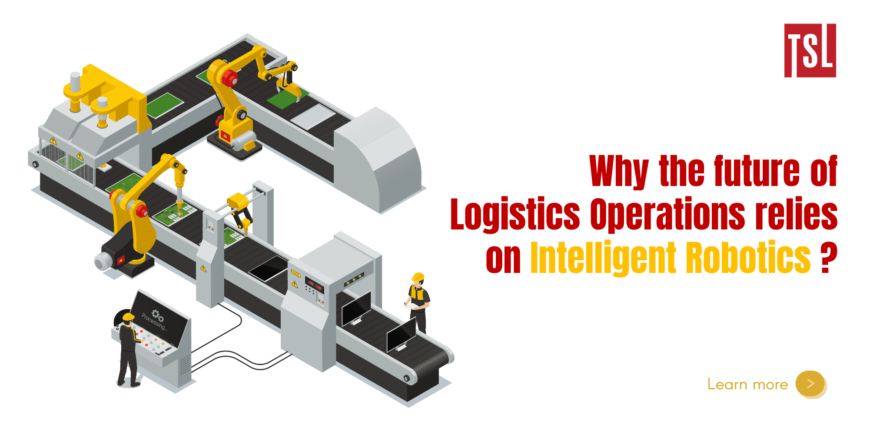Why the future of Logistics operations relies on Intelligent Robotics?
Modern robotics technology has the potential to optimize supply chains by making them robust and resilient to handle dynamic supply chain and logistics requirements.
Logistics operations have traditionally been heavy in their reliance on manpower. But with the current complex market dynamics, soaring operational costs and scarce manpower, there is a need to automate logistics now more than ever. To fulfill increasing volumes and sporadic demand, e-commerce and third-party logistics (3PL) players are looking to streamline their logistics operations to make them highly responsive and adaptable. The answer? Flexible and scalable intelligent robotic automation.
Modern robotics technology has the potential to optimize supply chains by making them robust and resilient to handle dynamic supply chain and logistics requirements and trends. Here is why the future of logistics operations across the world relies on robotics.
Current challenges in logistics
The logistics industry currently is riddled with several challenges such as rising consumer expectations and demands, inaccuracy and inefficiency of operations, and unavailability of skilled manpower as well as specialized experts. So far, this has tied logistics operations closely with high operational costs, damages, pilferages and errors leading to reduced customer satisfaction. With the ongoing sharp rise in online buying behaviour, it is, therefore, imperative for industry players to overcome these issues and leverage the benefits of automation to better serve end consumers.
Enter robotics tech
Autonomous Mobile Robots (AMRs) and Automated Guided Vehicles (AGVs) are at the forefront of robotics tech in logistics automation and help solve a lot of the operational and manpower-related challenges mentioned earlier. They can navigate their environment by using high-definition cameras, sensors, magnetic tapes, laser, Machine Learning (ML) and Artificial Intelligence (AI) algorithms while working alongside humans. Here is what AMRs/AGVs bring to the table:
Higher processing speed: The movement of goods can be easily outsourced to AMRs/AGVs. With a fleet, they can keep the logistics operations running continuously for 24 hours with rotation and do so with high accuracy and energy efficiency.
Higher personnel productivity: With AMRs/AGVs taking over mundane and repetitive tasks, human resources can be freed up to focus on other key departments. This helps in significantly increasing personnel productivity.
Sustainable workflow: Thanks to unique AI algorithms, AMRs/AGVs can compute the shortest and most efficient path for material handling while manoeuvrings around human workers. This makes them highly adaptable, sustainable, energy and process-efficient.
Less area required: Several small and mid-sized warehouses and fulfillment center operate with limited space availability. AMRs/AGVs come in handy here as they are a lot more compact compared to other material handling systems. This helps in employing them even in smaller logistics outfits.
Lowers personnel injuries and damage to goods: The ability of AMRs to navigate around other workers and obstacles prevents collisions and helps reduce workplace injuries and damages.
Trends driving AMR adoption
Need for automation in post-COVID economy: From the onset of COVID-19, automation has become an indispensable tool that has supercharged many industries in terms of efficiency and speed. Since it is actively sought out in the current climate, there is a big demand for AMRs/AGVs to automate supply chains and improve overall efficiency and productivity in logistics operations.
Rise in micro fulfillment: With the rise of quick commerce and customer expectations, there is a need for an omni-channel approach to fulfillment. This need has brought about a big demand for AMRs/AGVs that facilitate automation in both the consumer and industrial sectors. Consequently, this has led to an increase in micro fulfillment center which are outfitted with these scalable and dynamic robotic solutions that can meet the current market needs.
RaaS (robotics-as-a-service): One of the key proponents for increased AMR/AGV adoption is the availability of the RaaS (Robotics-as-a-Service) model. RaaS makes automation a possible scenario for many e-commerce, retail and logistics companies by lowering adoption barriers. Some of its benefits include, low cost for automation adoption, energy efficiency, easy scalability based on business requirements, and all inclusive service (i.e. installation, maintenance and training).
Robotics is the future
AMRs/AGVs can optimize and revolutionize logistics like never before. They are incredibly agile, dynamic, scalable, energy, process, space and cost-efficient, all the ingredients needed to run a highly optimized logistics supply chain. With AMRs/AGVs’ efficiency combined with RaaS’s flexibility, running a logistics operation which is both sustainable and scalable to handle modern customer expectations is now a reality.
*Source: www.entrepreneur.com, translated by vlr.vn









